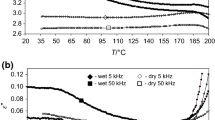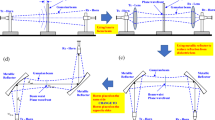Abstract
In this article, we report results on the behavior of selected proteins in solution and on how they could affect the overall absorption and distribution of electromagnetic energy within dielectrically heated biomaterials. Ovalbumin, bovine serum albumin (BSA), β-lactoglobulin (BLG), and lysozyme (Lys) proteins varying in molecular weight, structure, and isoelectric point were systematically screened for this study. Measurements were performed using an open-ended coaxial probe over a frequency range encompassing the industrial, scientific, and medical (ISM) bands (1–1800 MHz) at six concentration levels and 25 °C. Primary findings include discovery of an additional δ-dispersion region in addition to the previously observed two regions between the well-established β- and γ-dispersion regions for protein solutions, which we propose are a sub-set of multiple δ-dispersions in the said region. We hypothesize that the β-dispersion is a summation of these multiple δ-dispersions and their cumulative effect is manifested in the amount of heat generated within a dielectrically treated biomaterial. An individual protein’s contribution to the overall dielectric absorption was quantitatively determined to account for up to 10% of the energy absorbed by free water molecules. We derived a mixture formula that accurately predicted the dielectric constant (ε′) at the critical industrial 915 MHz frequency, which we propose to use in computational simulations for purposes of design and development of dielectric heating devices. Theoretical calculation of the local ε′ of individual proteins from their amino acid makeup resulted in an average of 2.7, closely matching previously reported results. An increase in the physical size of a protein resulted in a decrease in the overall electromagnetic absorption of the mixture. A similar effect was observed as protein concentration increased with more pronounced effects on the dielectric increments (∆ε′) and absorption decrements (∆ε″); the implication of such effect on energy absorption and heating is discussed.










Similar content being viewed by others
References
Al-Holy, M., Wang, Y., Tang, J., & Rasco, B. (2005). Dielectric properties of salmon (Oncorhynchus keta) and sturgeon (Acipenser transmontanus) caviar at radio frequency (RF) and microwave (MW) pasteurization frequencies. Journal of Food Engineering, 70(4), 564–570.
Alshami, A., Wang, Y., Tang, Y., & Rasco, B. (2007). Dielectric properties of food carbohydrates-proteins aqueous mixtures. Annual microwave heating symposium 2007. International Microwave Power Institute, p. 84.
Cametti, C., Marchetti, S., Gambi, C., & Onori, G. (2011). Dielectric relaxation spectroscopy of lysozyme aqueous solutions: analysis of the δ-dispersion and the contribution of the hydration water. The Journal of Physical Chemistry B, 115(21), 7144–7153.
Cullen, P. J., & Tiwari, B. K. (2011). Novel thermal and non-thermal technologies for fluid foods. Amsterdam: Academic.
Debye, P. J. W. D. (1929). Polar molecules / by P. Debye. New York: Dover.
Deloor, G. P. (1964). Dielectric properties of heterogeneous mixture. Applied Scientific Research, B(11), 310–319 310.
El Moznine, R., Smith, G., Polygalov, E., Suherman, P. M., & Broadhead, J. (2003). Dielectric properties of residual water in amorphous lyophilized mixtures of sugar and drug. Journal of Physics D-Applied Physics, 36(4), 330–335.
Essex, C. G., Symonds, M. S., Sheppard, R. J., Grant, E. H., Lamote, R., Soeewey, F., Rosseneu, M. Y., & Peeters, H. (1977). Five-component dielectric dispersion in bovine serum albumin solution. Physics in Medicine and Biology, 22(6), 1160–1167.
Foster, K. R., & Schwan, H. P. (1989). Dielectric properties of tissues and biological materials: a critical review. Critical Reviews in Biomedical Engineering, 17, 25–104.
Fricke, H., Schwan, H. P., Li, K., & Bryson, V. (1956). A dielectric study of the low-conductance surface membrane in E. coli. Nature, 177(4499), 134–135.
Gabler, R. (1978). Electrical interactions in molecular biophysics : an introduction. New York: Academic.
Gabriel, C., Gabriel, S., Grant, E. H., Halstead, B. S. J., & Mingos, D. M. P. (1998). Dielectric parameters relevant to microwave dielectric heating. Chemical Society Reviews, 27, 213–223.
Grant, E. H. (1966). Dielectric dispersion in bovine serum albumen. Journal of Molecular Biology, 19(1), 133–139.
Grant, E. H., Keefe, S. E., & Takashima, S. (1968). The dielectric behavior of aqueous solutions of bovine serum albumin from radiowave to microwave frequencies. The Journal of Physical Chemistry, 72(13), 4373–4380.
Grant, E. H., South, G. P., Takashima, S., & Ichimura, H. (1971). Dielectric dispersion in aqueous solutions of oxyhaemoglobin and carboxyhaemoglobin. The Biochemical Journal, 122(5), 691–699.
Grant, E. H., Sheppard, R. J., & South, G. P. (1978). Dielectric behaviour of biological molecules in solution. Oxford: Clarendon Press.
Grant, E. H., Mcclean, V. E., Nightingale, N. R., Sheppard, R. J., & Chapman, M. J. (1986). Dielectric behavior of water in biological solutions: studies on myoglobin, human low-density lipoprotein, and polyvinylpyrrolidone. Bioelectromagnetics, 7(2), 151–162.
Hagmann, M. J., Levin, R. L., Calloway, L., Osborn, A. J., & Foster, K. R. (1992). Muscle-equivalent phantom materials for 10-100 MHz. IEEE Transactions on Microwave Theory and Techniques, 40(4), 760–762.
Harvey, S. C., & Hoekestra, P. (1972). Dielectric relaxation spectra of water absorbed on lysozyme. The Journal of Physical Chemistry, 76(21), 2987–2994.
Hasted, J. B. (1973). Aqueous dielectrics. London: Chapman and Hall [Distributed in the U.S.A. by Halsted Press, a division of J. Wiley & Sons, New York.
von Hippel, A. R. (1995). Dielectric materials and applications. Boston: Artech House.
Kappe, C. O., Stadler, A., & Dallinger, D. (2012). Microwaves in organic and medicinal chemistry. Weinheim: Wiley.
Kirkwood, J. G., & Shumaker, J. B. (1952). The influence of dipole moment fluctuations on the dielectric increment of proteins in solution. Proc. N. A. S., 38, 855–862 855.
Mehdizadeh, M. (2015). Microwave/RF applicators and probes: for material heating, sensing, and plasma generation. William Andrew. Amsterdam.
Mijovic, J., Bian, Y., Gross, R. A., & Chen, B. (2005). Dynamics of proteins in hydrated state and in solution as studied by dielectric relaxation spectroscopy. Macromolecules, 38(26), 10812–10819.
Mishra, R. R., & Sharma, A. K. (2016). Microwave–material interaction phenomena: heating mechanisms, challenges and opportunities in material processing. Composites Part A: Applied Science and Manufacturing, 81, 78–97.
Mudgett, R. E. (1986). Electrical properties of foods. In M. A. Rao & S. S. H. Rizvi (Eds.), Engineering properties of foods (pp. 329–390). New York: Marcel Dekker.
National Research Council (U.S.). Committee on Microwave Processing of Materials: an emerging industrial technology, Netlibrary Inc., National Research Council (U.S.). National Materials Advisory Board. and National Research Council (U.S.). Commission on Engineering and Technical Systems (1994). Microwave processing of materials.
Nüchter, M., Ondruschka, B., Bonrath, W., & Gum, A. (2004). Microwave assisted synthesis—a critical technology overview. Green Chemistry, 6(3), 128–141.
Oleinikova, A., Sasisanker, P., & Weingärtner, H. (2004). What can really be learned from dielectric spectroscopy of protein solutions? A case study of ribonuclease A. The Journal of Physical Chemistry B, 108(24), 8467–8474.
Oncley, J. L. (2003). Dielectric behavior and atomic structure of serum albumin. Biophysical Chemistry, 100(1–3), 151–158.
Pennock, B. E., & Schwan, H. P. (1969). Further observations on the electrical properties of hemoglobin-bound water. The Journal of Physical Chemistry, 73(8), 2600–2610.
Pethig, R. (1979). Dielectric and electronic properties of biological materials. Chichester, Wiley.
Resurreccion, F., Luan, D., Tang, J., Liu, F., Tang, Z., Pedrow, P., & Cavalieri, R. (2015). Effect of changes in microwave frequency on heating patterns of foods in a microwave assisted thermal sterilization system. Journal of Food Engineering, 150, 99–105.
Reynolds, J. A., & Hough, J. M. (1957). Formulae for dielectric constant of mixtures. Proceedings of the Physical Society, I.XX(8), 760–775.
Sasaki, K., Isimura, Y., Fujii, K., Wake, K., Watanabe, S., Kojima, M., Suga, R., & Hashimoto, O. (2015). Dielectric property measurement of ocular tissues up to 110 GHz using 1 mm coaxial sensor. Physics in Medicine and Biology, 60(16), 6273.
Schutz, C. N., & Warshel, A. (2001). What are the dielectric "constants" of proteins and how to validate electrostatic models? Proteins: Structure, Function, and Genetics, 44, 400–417.
Schwan, H. P. (1965). Electrical properties of bound water. Annals of the New York Academy of Sciences, 125, 344–354.
Schwan, H. P. (1983). Electrical properties of blood and its constituents: alternating current spectroscopy. Blut, 46(4), 185–197.
South, G. P., & Grant, E. H. (1974). Theory of dipolar relaxation in aqueous macromolecular solutions. Biopolymers, 13(9), 1777–1789.
Stratton, J. A. (1941). Electromagnetic theory (1st ed.). New York: McGraw-Hill Book Company, Inc..
Stuchly, M. A., Athey, T. W., Samaras, G. M., & Taylor, G. E. (1982). Measurement of radio frequency permittivity of biological tissues with an open ended coaxial line: part II—experimental results. IEEE Transactions on Microwave Theory and Techniques, 30(1), 87–92.
Suherman, P. M., Taylor, P., & Smith, G. (2002). Low frequency dielectric study on hydrated ovalbumin. Journal of Non-Crystalline Solids, 305(1–3), 317–321.
Sun, E., Datta, A., & Lobo, S. (1995). Compsition-based prediction of dielectric properties of foods. Journal of Microwave Power and Electromagnetic Energy, 30(4), 205–212.
Swiss Institute Of Bioinformatics (SIB) 2006. The ExPASy (Expert Protein Analysis System) proteomics server. The ExPASy (Expert Protein Analysis System) proteomics server http://www.expasy.org/.
Takashima, S. (1972). Dielectric dispersion measurement of dielectric constant and conductivity. Methods in Enzymology, 26 PtC, 337–362.
Tang, J., Feng, H., & Lau, M. (2001). Microwave heating in food processing. In X. Young, J. Tang, C. Zhanege, & W. Xin (Eds.), Advances in agricultural engineering. New York: World Scientific Publisher.
Thuéry, J., & Grant, E. H. (1992). Microwaves: industrial, scientific, and medical applications. London: Artech House.
Tribelsky, M. I., & Fukumoto, Y. (2016). Laser heating of dielectric particles for medical and biological applications. Biomedical Optics Express, 7(7), 2781–2788.
Wang, S., Monzon, M., Gazit, Y., Tang, J., Mitcham, E. J., & Armstrong, J. W. (2005). Temperature-dependent dielectric properties of selected subtropical and tropical fruits and associated insect pests. Transactions of the ASAE, 48(5), 1873–1881.
Wig, T. (2001). Sterilization and pasteurization of foods using radio frequency heating. Washington: Washington State University.
Wig, T., Tang, J., Wang, Y., Hallberg, L.M. and Koeral, A., 2000. FDTD simulation of energy distribution in packaged foods during rf heating. 2000, ASAE Annual International Meeting.
Wolf, M., Gulich, R., Lunkenheimer, P., & Loidl, A. (2012). Relaxation dynamics of a protein solution investigated by dielectric spectroscopy. Biochimica et Biophysica Acta (BBA)-Proteins and Proteomics, 1824(5), 723–730.
You, K., Abbas, Z., Malek, M., Cheng, E., & Mun, H. (2012). Modeling of dielectric relaxation for lossy materials at microwave frequencies using polynomial approaches. Jurnal Teknologi, 58(1).
Acknowledgments
This research was supported in part by the ND EPSCoR through NSF grant #IIA-135466 and through ND EPSCoR State funds. The authors also thank the U.S. Department of Agriculture, National Needs Fellowship grant program (2012-38420-19287).
Author information
Authors and Affiliations
Corresponding author
Rights and permissions
About this article
Cite this article
Alshami, A.S., Tang, J. & Rasco, B. Contribution of Proteins to the Dielectric Properties of Dielectrically Heated Biomaterials. Food Bioprocess Technol 10, 1548–1561 (2017). https://doi.org/10.1007/s11947-017-1920-5
Received:
Accepted:
Published:
Issue Date:
DOI: https://doi.org/10.1007/s11947-017-1920-5




